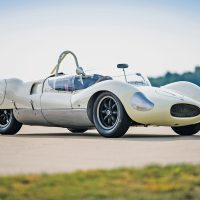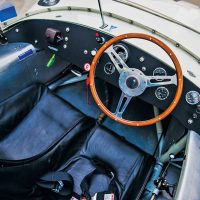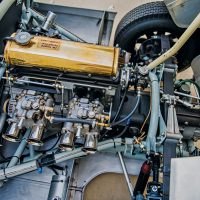SCM Analysis
Detailing
| Vehicle: | 1959 Cooper-Climax Monaco T49 Mk I |
| Years Produced: | 1959–60 (Mk I and II) |
| Number Produced: | 10 |
| Original List Price: | $8,250 |
| SCM Valuation: | $257,000 (this car) |
| Chassis Number Location: | Tag riveted on frame tube |
| Engine Number Location: | Left front of block |
| Club Info: | Historic Motor Sports Association |
| Website: | http://www.hmsausa.com |
| Alternatives: | 1959 Lotus 15, 1960 Lotus 19, 1959 Porsche RS60 |
| Investment Grade: | A |
This car, Lot 2184, sold for $257,600, including buyer’s commission, at RM Sotheby’s Elkhart Collection sale in Elkhart, IN, on October 24, 2020.
Probably the most important thing to remember when discussing Cooper Monaco racers is that though the name was constant and they all looked pretty similar, there were three distinct variations built between 1959 and 1964. The later ones are stronger, more sophisticated, and faster, as you would expect, but the early ones are by far the more valuable, and herein lies the core of our story.
A bit of history
Charles and John Cooper started building racing cars with the 500-cc, single-seater “Mark 1” in 1946. It was for their own use, but their father had a garage business, so when they showed some success, it was a simple move to building cars for customers. By 1950 the Cooper Car Company was well established as the premier constructor for the 500-cc International Formula 3 races.
As an interesting aside, the original “Mark 1” was constructed by taking the front halves of two wrecked pre-war Fiat Topolinos and butt-welding them together for an all-independent suspension chassis. The Fiats used a transverse leaf spring as the upper suspension arm, which was simple and light, if not very trendy. Cooper liked it so well that they used the transverse leaf in the back on every design through 1959, including that year’s world-championship F1 car.
It is useful to note that the Cooper Car Company was not a hobby, some wealthy guy’s vanity project or an attempt at a national team like BRM. It was a regular (if small) business that made its money building and selling racing cars. Its primary product was single-seaters, but if they could sell sports racers, they were all over it. In the mid-1950s they had found success with the “Bobtail,” effectively an 1,100-cc Formula 2 car with full bodywork and a vestigial passenger’s seat fit on one side to meet the rules. By the late 1950s, sports-car racing had become a major draw both in Europe and the U.S., so it seemed time to build a large-engine sports racer. Being Cooper, it would be a mid-engine configuration.
A Grand Prix 2-seater
The new Cooper Monaco, named to honor Maurice Trintignant’s win there (in a Cooper F1, of course) was introduced in November 1958. The traditional Cooper formula car frame was a long box with 1.5-inch round tubes bent in an arc around the driver; for the 2-seater they left the front and back narrow but bent all four tubes more severely out and back to make a box in the middle for driver and passenger. This allowed Cooper to use their tried-and-true F1 suspension setup with little modification. The Monaco was effectively a 2-seat T-51 Grand Prix car.
The original design anticipated using the 4-cylinder Climax FPF racing engine in 2.0- or 2.5-liter displacement, though Cooper was happy to sell cars without engines, and several ended up with 2.5-liter Maserati power. Engines were mated to the Citroën-ERSA 4-speed transaxle (Parisian case, all custom British internal gears; also from Formula 1), the first to be able to handle the torque of the 2.5-liter engine. The body was formed of aluminum, which in today’s world is immensely important in terms of collectibility, and it continued to use the transverse-leaf-rear-spring setup.
Introduced in late 1958, the Monaco was ready for the 1959 season, where its primary competition was the front-engine Lotus 15. The eight 1959 cars were sold to the U.K., Europe, and the U.S., and all proved very quick. Everywhere it raced in 1959, the Monaco was the car to beat. An additional two cars (Mk II) were built in 1960, mechanically the same but with a different nose shape for better aerodynamics. That year saw Lotus introduce its first mid-engine sports racer, the 19. With a true space-frame chassis and more advanced suspension, it quickly served notice that Cooper was going to have to up its game to remain competitive.
Evolving technology
Cooper responded in 1961 with the Mk III Monaco. The basic chassis was the same, but the “bent” primary tubes were straightened out to increase torsional rigidity, and the transverse-leaf rear suspension was finally replaced with modern coil-over shocks and springs. With an eye toward the American market, the bodywork sprouted big fins at the rear. It was a much better car than the first ones, but European interest in this series was flagging; two of the three Mk III Monacos went to the U.S. The Mk IV for 1962 was basically unchanged and all six went to the U.S.
The nascent professional sports-car racing series in the U.S. was getting serious and the new Monaco was the best weapon for that battle. It was quick and the robust chassis design proved more durable than the Lotus 19. The big advantage was that the chassis could easily handle American V8 power, and as the U.S. horsepower wars got going, Monacos started getting V8s. For 1963 and 1964 the Monaco was strengthened, renamed the Type 61M, and all went to the U.S. without engines. The most famous went to Shelby to become “King Cobras.” Then the tire revolution happened and everything earlier was replaced with Lolas and McLarens. The era was over.
Assessing the market
So there you have the Cooper Monaco story — now let’s talk about what is desirable in the market. The aluminum body is a major plus, and most Monacos have excellent history (though almost all have been crashed badly at least twice), but these cars will never carry collector value like an equivalent Italian racer. Their primary value is on the weapons-grade side — whether you can have fun and win at the track. The problem is that the Monaco spans a huge technological change. The early ones were breathtakingly new and competitive, the later ones were dinosaurs on their way to extinction. They are still fun to drive, but old and relatively slow.
This gap is exacerbated by the FIA international racing groups, which break at 1960 and 1965. The transverse-spring cars are the kings of their grids, but the new cars have to run against Lola T70s, which relegate them to backmarkers at best. The result is that early cars are far more valuable than the late ones (with exceptions made for famous cars like King Cobras).
In the U.S. we don’t use FIA rules, but the later cars are still outliers. Mk I and Mk II Monacos have traded hands in the $250k–$350k range for at least the past 15 years, on the high side of the weapons-grade values, trending down a bit lately along with the general collector market. This was a good car, fairly bought. ♦
(Introductory description courtesy of RM Sotheby’s.)




